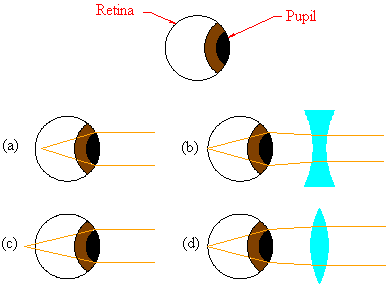Taking a look at the eye
The first step in seeing an image comes when light rays enter through the cornea, the clear front or "window" of the eye. The strength of the cornea refracts the light in such a way that it can pass freely into the pupil, the opening in the center of the iris. The iris is basically a shutter for a camera inside our eye and it has the ability to enlarge and shrink an image depending on the amount of light entering into the eye. After the light passes through the iris it goes through the eye's natural crystalline lens which lengthens and shortens itself in order to focus the light rays correctly and properly. The light rays then move through a clear gel-like substance called the vitreous which fills the globe of the eyeball and helps the eye hold its spherical shape. In a healthy eye the light rays come to a sharp focusing point that is on the retina. The retina is essentially the film in a camera except for your eye, its job is to capture all the light rays and turn them into impulses that are then transmitted to hundreds of thousands of millions of nerve fibers that are in the optic nerve, which are carried to the brain where the image is seen and recognized by the brain.
How the Human Eye Works | Cornea Layers/Role | Light Rays. (n.d.). Retrieved February 17, 2016, from http://www.nkcf.org/how-the-human-eye-works/

Applications of Mirrors and Lenses. (n.d.). Retrieved March 03, 2016, from https://www.math.ubc.ca/~cass/courses/m309-01a/chu/Applications/apps.htm
Development problems and diseases are crippiling to the eye regardles of age or the severity of the condition. Even if the rest of the eye is 100% ok and there are zero problems the vision is still completly affected and must be treated as soon as possible as the lack of use can cause serious other conditions that will permanently destroy the eye's ability to see and transmit. Some eye conditions that affect many people's vision is nearsightedness and faresightedness. Nearsightedness (a) (b) can be explained by the retina not focussing properly on the light rays that are entering the eye causing the inner section of the light rays to intersect in front of the retina. The individual will encounter difficulty in seeing things clearly unless they are close to the eye. Alternatively, farsightedness (c) (d) is another condition that can occur. Farsightedness occurs when the intersection occurs behind the retina. This condition enables the person to be able to see objects far away but up close they will be blurry. This can be seen in the images on the right and how the the vision is corrected using the appropriate lenses.
How the Human Eye Sees. (n.d.). Retrieved February 17, 2016, from http://www.webmd.com/eye-health/amazing-human-eye
Where and how problems occur within the eye

The Human Eye: A Diagram. (n.d.). Retrieved March 01, 2016, from http://www.familyconnect.org/info/after-the-diagnosis/working-with-medical-professionals/the-human-eye/135
